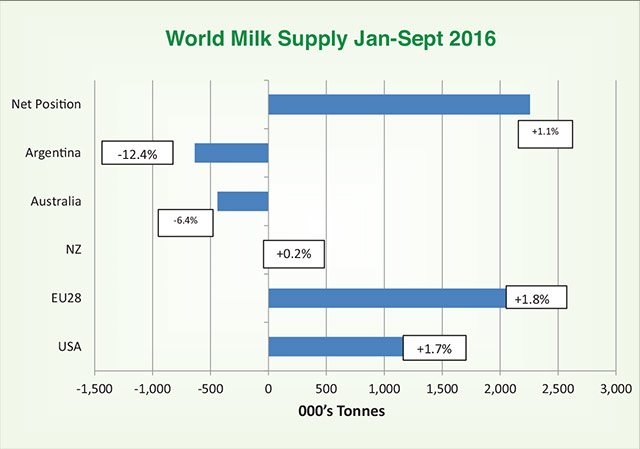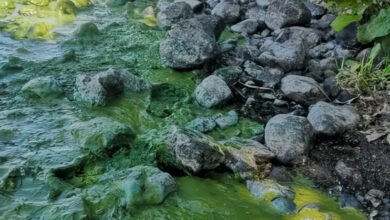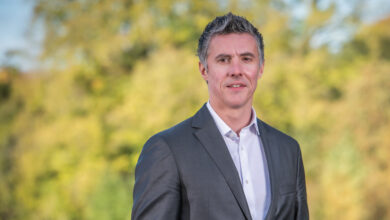Oil and milk prices are closely linked

CEO of LacPatrick, Gabriel D’Arcy, discusses the correlation between rising oil prices and increased spending on dairy products.
LacPatrick CEO Gabriel D’Arcy told delegates attending the agendaNi’s Agriculture & Food Conference 2016 that global oil prices had surged by 15 per cent in the wake of the decision by the Organisation of the Petroleum Exporting Countries (OPEC) countries to cut output by 1.2 million barrels per day.
“This is the first time in almost two years that oil markets have nudged ahead of $50 per a barrel,” he said. “This is significant as $50 is the price at which the world’s oil producing nations will start to actively purchase dairy products.”
According to D’Arcy, approximately 40 per cent of the world’s dairy trade is normally done with oil exporting nations. “The rise in prices increases their purchasing power and consumption, which is positive for dairy consumption. However, it will take some time and a sustained $50/barrel price plus to generate this demand.
“There is a strong link between oil and dairy prices on international markets,” he explains. D’Arcy points out that 2016 was the first year for some time when total global dairy output has not increased: “Given the dairy output reductions now taking effect in the EU and New Zealand, it looks like we could be seeing a zero gain in milk output around the world. This will have a stabilising impact on prices.
“Volatility is now a major factor impacting on all the world’s food commodity markets. Over the last couple of years milk producers have been coping with the downward phase of the cycle, where dairy is concerned. However, recent weeks have seen milk prices recover quite significantly. Future farmer prices will be driven by demand.”
D’Arcy said that, according to current OECD predictions, global dairy consumption is likely to increase by 27 per cent during the period 2013 to 2023. “We are also seeing changes in attitude impacting on the way that dairy products are perceived. Thirty years ago butter was widely regarded as being very unhealthy, from a dietary point of view. This perception is now changing, with the result that demand for butter is significantly increasing in North America and Europe. All of this is good news for the milk sector here in Ireland.”
LacPatrick was formed in July 2015 as a result of the merger of Ballyrashane and Town of Monaghan Co-ops. The business has a combined turnover of €360 million and employs 300 people. Over 1,050 farmers deliver 600 million litres of milk annually and the company supplies leading retailers, food service and industry customers across the globe with fresh dairy products from their manufacturing sites. A significant part of the business is export-led.
D’Arcy joined Town of Monaghan Co-op in August 2014. He spent the previous seven years as Managing Director of Bord na Móna, where he led the transformation of the organisation to deliver its vision ‘A New Contract with Nature’.
Prior to this, D’Arcy worked for almost 20 years with the Kerry Group and was closely involved in the rapid expansion of Kerry’s Ingredients Division in Europe of which he became Commercial Director. He began his career in the Irish Defence Forces where he served for 12 years, both at home and abroad.

D’Arcy made his conference presentation against the backdrop of LacPatrick’s ongoing investment in state-of-the-art milk drying facilities at Artigarvan in north County Tyrone.
“The new plant should come on stream commercially at the beginning of April next year. We are 95 per cent of the way there, in terms of installing the new facilities. After that it’s a case of testing the new operation and making sure that any snags are ironed out,” he explains.
“The new dryer represents a £30 million investment and will provide a continuous processing outlet for the milk produced by our 650 farmer suppliers in Northern Ireland. It has taken us five years to take the project through from concept to the stage we are at now. The new plant, which has a capacity of 7t/hour, replaces the two dryers that were previously on site at Artigarvan.”
D’Arcy adds the new drying facility can produce powder to infant formula standard. It can process 54,000 litres of milk per hour and will add to the existing milk drying facilities already on-site at Artigarvan. “The new plant can also produce instantised whole milk powder and agglomerated skimmed milk powder. Instantised powders are used to produce drinking milk in regions such as West Africa, where we already have a strong market presence. We want to develop this business further. Our LP yoghurt is already a market leader in that part of the world. The new drying operation at Artigarvan is a good news story for all our farmer suppliers in Northern Ireland.”
In addition to Artigarvan, LacPatrick processes milk at two other sites. Ballyrashane Creamery boasts a number of ‘firsts’ in technology terms, including it being the first dairy in Ireland to collect bulk milk; the first to install a leading edge butter facility; and the first to get all of its electrical energy from a purpose-built anaerobic digester plant on site.
Ballyrashane Creamery has a substantial liquid milk business. Recent investment has doubled the previous manufacturing capacity for butter and has enabled the business to increase sales of its innovative premium butter products, as well as opening up new global opportunities. A key development has been the investment in a new plant and process which makes texturized butter, making this site one of only five in the world with this capability. The site also makes Regato cheese for the export market.
Alongside its substantial milk and butter processing businesses, LacPatrick’s Monaghan plant is increasingly focused on creating a centre of excellence in yoghurt innovation and manufacture. A large scale purpose built plant offers lots of flexibility due to eight different lines providing production capabilities across multiple formats and sizes.
The plant can support processed and finished yoghurt, dessert and cultured buttermilk production. To support there focus in yoghurt innovation, the company recently invested in a pilot plant, which mimics the production line in smaller runs. A cross-functional new product development team works closely with customers and partners to develop new products. There is a new R&D Laboratory, based in the yoghurt plant, where ongoing research and development is carried out.
D’Arcy says that the new company has strong ambitions to develop its business across the island of Ireland and beyond: “Critical to this global growth strategy are our significant investments in innovation and technology, and our particular focus on sustainability and the environment. Our vision and strategy will ensure clear and enduring market leadership and will allow us to continue to make competitive and sustainable returns to our co-op members. There are great synergies between the two newly merged companies: a passion for excellent product quality, a shared geography, and complementary production facilities, technologies and customers.”






